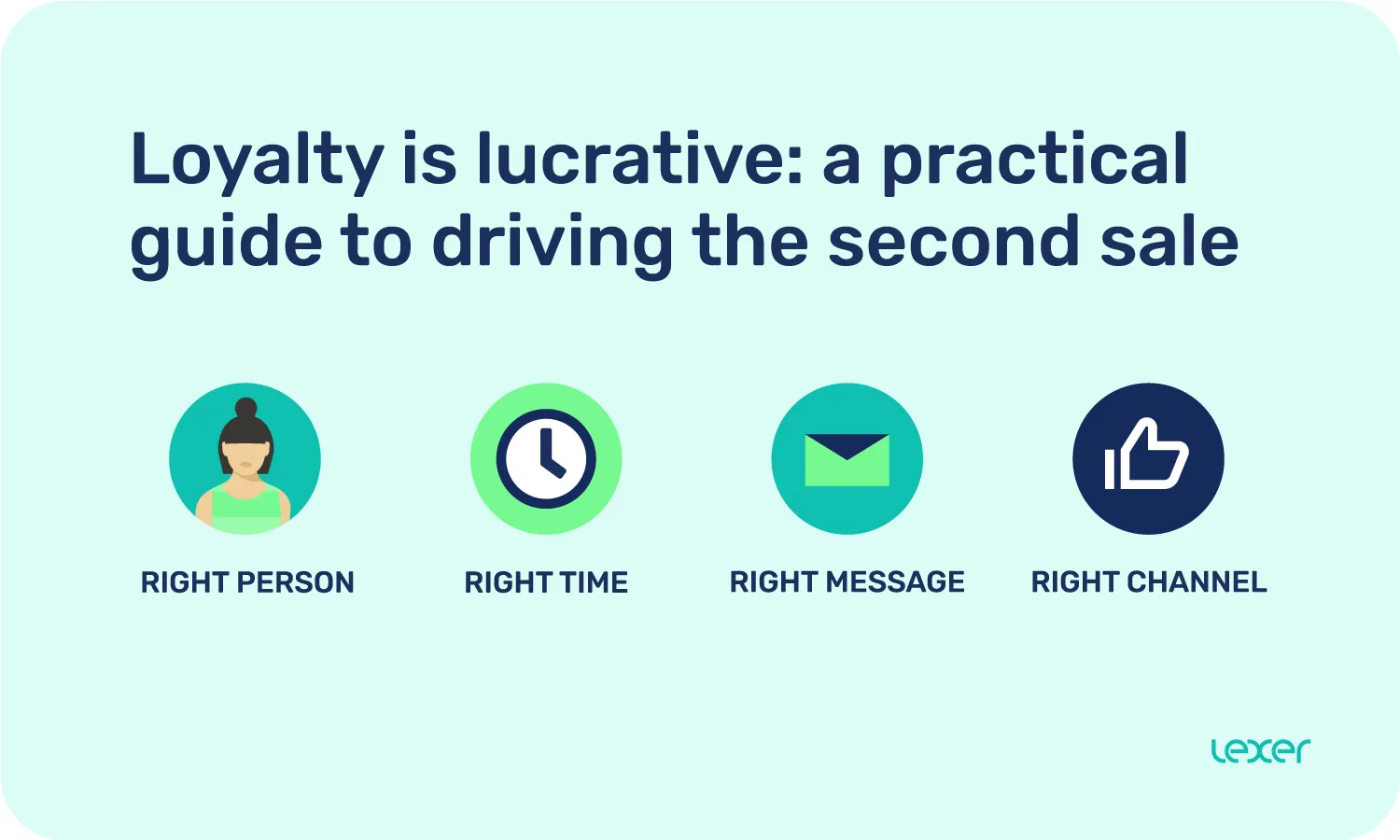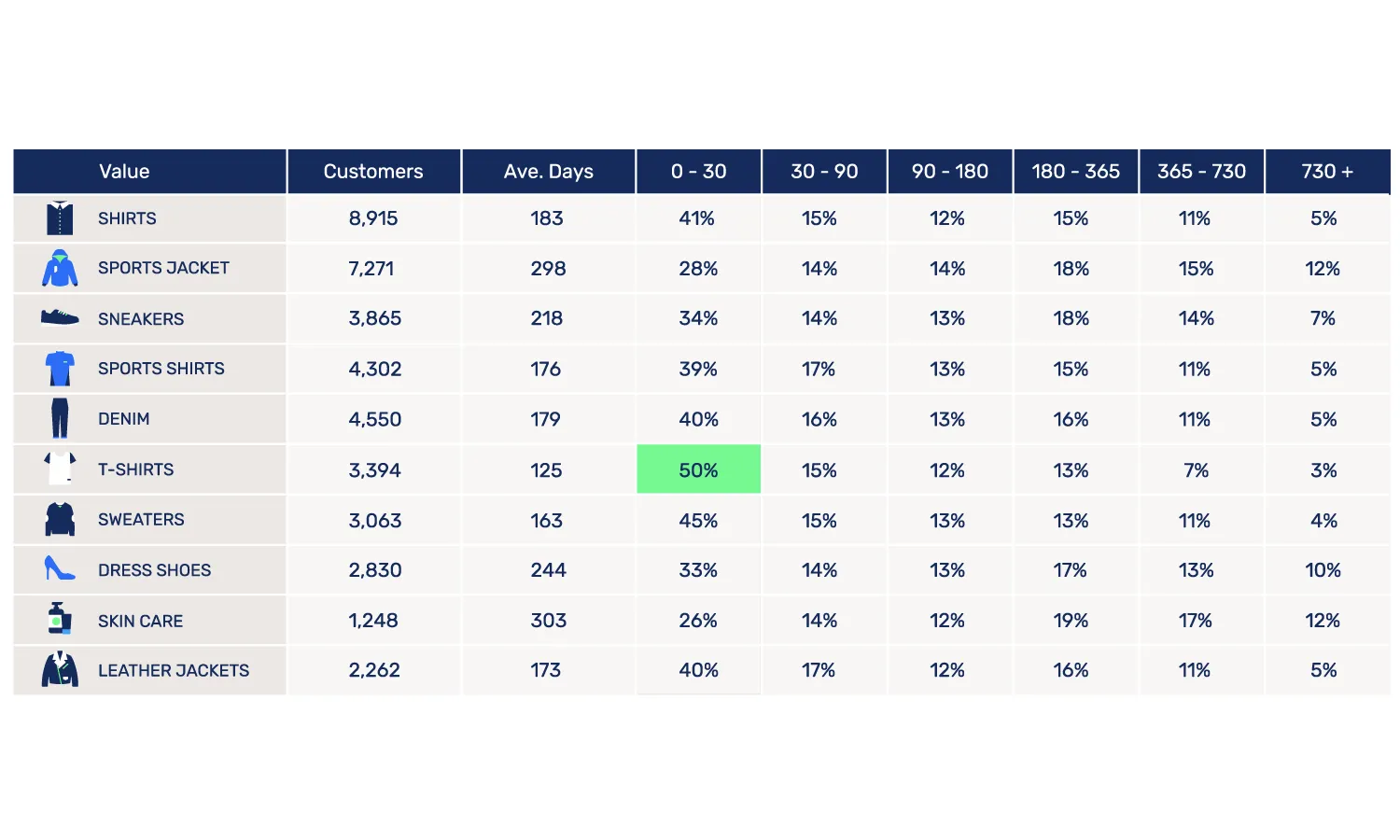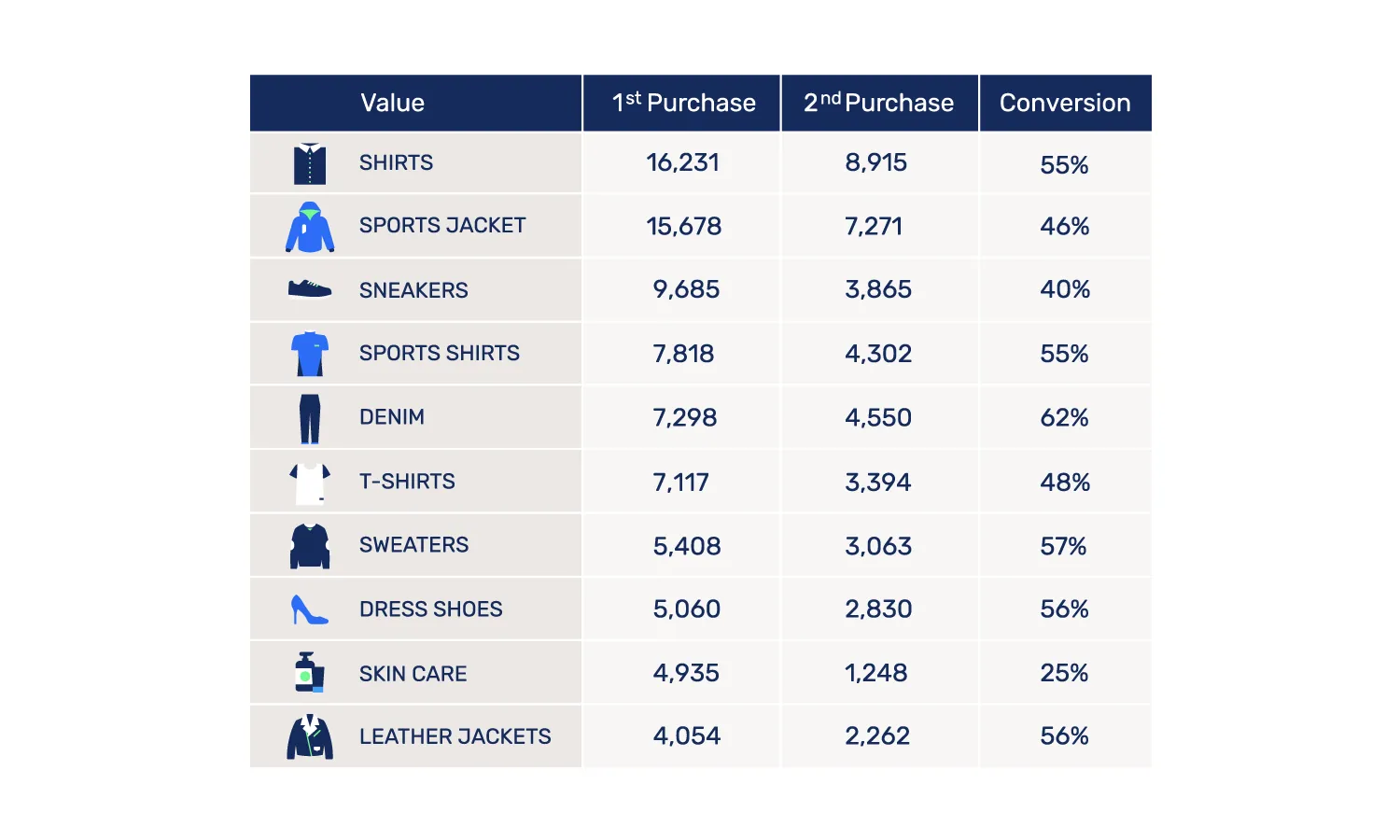December 10, 2019
An upsell marketing strategy to convert the second sale
Katherine Barchetti, a well-known upscale retailer said, “make a customer, not a sale.” Why? Because a loyal customer provides substantially more value to your company than a one-off sale ever could. Every time a customer comes back to make a repeat purchase, they’re driving up their customer lifetime value with no additional acquisition costs—but effective upselling and cross-selling in retail can be challenging without data. Here's how to upsell to first-time buyers to convert the second sale.

In that way, you might think of CLV as a partial measure of your customer loyalty. A great strategy for growing your CLV is developing stronger, longer-lasting relationships with your customers—and the most critical milestone for creating these loyal, long-term, and highly profitable relationships with your customers is the second conversion.
That’s right. The second conversion—not the first—is the most critical milestone for growing your CLV, because two-time buyers are nine times more likely to make repeat purchases than one-time buyers. With those odds, driving the second sale is a growth and profit strategy you can’t ignore.
Yet, the vast majority of DTC brands we’ve worked with have staggeringly high one-time buyer ratios. On average, 50 to 80 percent of their customers purchased once and never again.
This guide will teach you practical, data-driven upselling strategies to turn one-time buyers into repeat purchasers.
So what is it about the second sale that makes it such a common roadblock to developing loyal customers?
Converting first-time buyers to two-time buyers is a time-sensitive endeavor.
Think about the feeling you get when you’ve purchased from a new brand. Your attention and mind-share are at their greatest the day you place the order; if you buy it in-store, you can’t wait to go home and try it on. If you buy it online, you eagerly check the mailbox until it arrives.
This gradual atrophy of the “buyer’s high” means that retailers need to take action quickly to increase the likelihood of a second sale. The more time that passes after the first order, the more difficult it becomes to win the second order.
By engaging new customers with personalized, targeted, and timely marketing messages, you can maximize conversion to the second order and drive material increases in your overall CLV.
Luckily, customer data platforms (CDPs) make this type of analysis incredibly easy; they give even the leanest of marketing teams the ability to send timely and relevant messages to customers automatically. With enriched first- and zero-party customer data at your fingertips, you can:
- Develop a timed and targeted cross-sell strategy.
- Analyze which of your products have the highest likelihood of converting the second sale.
- Automate marketing messages to meet the right buyers at the right time in the right channels.
- Create long-lasting relationships with your customers, effectively boosting your average CLV.
- Increase your overall revenue and grow your business.
Here are four practical steps for automating the right message at the right time to convert one-time buyers into two-time (and more!) buyers with a CDP.
Maximize the second conversion with this 4-step upsell marketing strategy
Right Person
Every business loves their customers—but the truth is, not every customer is worth retargeting in paid campaigns.
Although it may be tempting to deliver your campaign to every one-time buyer in your database, you should avoid spending ad budget on churned or low-value audiences who are unlikely to buy from you again.
Use advanced audience targeting to reduce wasteful ad spend on irrelevant or unqualified audiences and boost the rate of conversions to the second order. Once you’ve filtered out contacts who are unlikely to become loyal customers, you can feel confident that you’re making the best use of your marketing dollars.
Right Time
Timing is everything.
If you send your marketing messages too soon after a customer’s first purchase, you run the risk of irritating them and turning them off from your brand. If you send your marketing messages too late, your customers’ delight and attachment to your brand may have faded too much for them to consider a second order.
Pinpointing the optimal time to send your next marketing message begins by understanding the average repurchase rates by product category. In other words, does the first product your customers purchase impact the amount of time it takes them to return for a second purchase?
The short answer is: Of course it does. In general, products with a shorter shelf life, such as socks or t-shirts, will always be purchased on a more frequent cadence than durable, long-lasting products like tires or leather jackets.
Understanding this cadence for each of your product categories will inform the timing and topic of your communication—but avoid relying on averages for this analysis, because averages can be misleading.
In the example below, the average time between first and second orders for t-shirts is 125 days. However, 50 percent of these customers made a second purchase within the first 30 days. In this instance, timing your marketing messages based on the average time to second order could result in a huge missed opportunity for influencing customer behavior.

Instead, optimize your timing toward the first half of your repeat customers who will be considering a second purchase within the first 30 days. In the same example, 56 percent of customers who buy denim and purchase again will do so within the first 90 days, which means the cross-sell conversation will also need to begin very soon after the initial purchase.
When you see high near-term repeat purchase rates like these, you can increase conversions and reduce the time to a second purchase by offering free or expedited shipping for orders placed within the next 30 days. This added incentive can persuade potential repeat customers who otherwise would not have considered purchasing again until 90 to 180 days had passed. The sooner a customer makes the crucial second purchase, the higher the likelihood that they’ll go on to become long-term brand enthusiasts.
On the other hand, slow repeat purchase rates present an opportunity to build and maintain your relationship with the customer. Providing care instructions, style guides, and other relevant content can help you build a deeper, more sustainable connection with the customer and keep your brand top-of-mind.
Right Message
The key to nailing your marketing message is two-fold:
1. Select the first-purchased product categories with the highest conversion rates to a second order. In the example below, this would be Denim.
2. For each product category selected in step 1, use your data to discover which products are most likely to be purchased next. In other words, if Denim is your highest-converting product category, which product do customers usually buy after making their first denim purchase? Shirts? Sneakers? More denim?
These insights will help you develop hyper-targeted marketing messages that boost conversions to the second order.
You can do this by creating customer cohorts defined by the product category that your customers purchase first. Then, measure how many of the customers in each cohort go on to place another order.
This exercise helps set your performance benchmarks and figure out where to focus your energy first. Look for product categories with a high volume of purchases and high conversion rates to the second order; these often present the biggest opportunity for ROI due to the number of customer interactions you can influence.

In this example, denim has the highest conversion rate of 62 percent, indicating that customers who purchase these products first have the most favorable brand experiences. Prioritizing this product category will help maximize return on investment.
On the contrary, skincare has a concerning second purchase conversion rate of only 25 percent—less than half that of other categories. When you notice a massive outlier like this, it usually points to an underlying issue with your product or with the type of customer that this product attracts.
So how do you know for sure? Customer satisfaction surveys like NPS can help you understand the variance across each category. Often times, fit, product durability, and price point exert the greatest influence on the conversion rate to second order. By understanding the real reasons that customers do or don’t return to make a second purchase, you can tailor your marketing messages to be more effective.
Now that you know which customers are most likely to make a second purchase and how long they’re likely to take before placing their next order, the next big question you need to answer is: What are they likely to purchase next?
Frequently, the second product purchased is in the same category as the first purchase. If this is the case, it’s usually a great sign that your customers love the product and are coming back for more. By surveying the customers who’ve displayed this pattern of behavior, you can uncover rich insight into the best ways to position these products in your marketing messages.
For example, if the majority of your customers say they returned to buy a second pair of sneakers because of their amazing fabric, then you may want to emphasize this feature in your ads—and you can use the same feature to encourage cross-sales into other categories.
Armed with this knowledge for each product category, you can be highly personalized in your follow-up communications and maximize conversions to the second order. By sending customers a simple email that says “thanks for your purchase! Based on your interest, here’s a hand-picked selection of products we think you’ll like,” you’ll delight your customers and boost sales.
Right Channel
Finally, it’s time to take all of this insight you’ve acquired and put it into action.
This step is where a CDP becomes extremely helpful. By enabling quick segment-building, real-time updates, and automated syncing to all of your marketing channels, a CDP provides marketers with a level of agility, efficiency, and effectiveness that they wouldn’t have access to if they approached this process manually.
First, create a segment for each product category that customers have purchased in their first order. As new customers are acquired, these segments will need to be updated, preferably in real-time and automatically.
If 50 percent of your customers buy within the following 30 days of their first purchase, then there’s not a lot of time to adjust your strategy as real-time data comes in. You need to start analyzing the impact of your campaigns as soon as possible to ensure maximum conversions.
Next, you’ll need to sync these segments with the channels you wish to take action on. We recommend using both paid and owned channels for maximum reach and ROI. As new customers are added to each segment, having them auto-update across all platforms will ensure that these customers are receiving timely and targeted communications across each channel. With these audiences available in both paid and owned channels, you can then set up the individual campaigns and follow-up sequences for each of your product journeys.
Once you’ve set up your audience and campaign automation, you can begin measuring the impact and optimizing your strategy. Focus on increasing the conversion rates from first to second order and reducing the average time to second order; if you can achieve both of these goals for your highest-value and highest-volume product categories, you can rapidly accelerate your revenue growth.
Upselling first-time buyers into repeat purchasers with a CDP
The second purchase is a crucial step in the customer journey because it’s the first signal of customer loyalty. If you can perfect your timing and pair it with relevant content, you’ll improve conversion rates to the second order and set your customers up for valuable, long-term engagements with your brand.
A CDP like Lexer can help you set up, automate, measure, and optimize these first-to-second-order campaigns with ease—and that makes it a vital tool for retailers to gather real-time insights and enhance their marketing efforts.
However, not every CDP is made the same, and it’s important that you pick the one that’s right for your specific needs. To learn the key questions you should ask before investing in a CDP to help you reach your growth goals, READ THIS NEXT.
Schedule a demo with our team to see how Lexer can help you drive the second sale.
Speak with our retail experts

